Numerical Modeling of Seawater Intrusion in Wadi Al-Jizi Coastal Aquifer in the Sultanate of Oman
Abstract
:1. Introduction
2. Study Area
3. Literature Review
3.1. Salinity Intrusion
3.2. Numerical Modeling
4. Methodology
4.1. Conceptual Model
4.2. Numerical Model
5. Results and Discussion
5.1. Steady-State Groundwater Flow Simulation
5.2. Transient-State Model Calibration and Validation
5.3. Transient State Solute Transport Model Calibration and Validation
5.4. Effect of Pumping Rates on Seawater Intrusion
5.5. Effect of Climate Change on Seawater Intrusion
6. Conclusions
Author Contributions
Funding
Institutional Review Board Statement
Informed Consent Statement
Data Availability Statement
Acknowledgments
Conflicts of Interest
References
- World Health Organization (WHO). Comprehensive Assessment of the Freshwater Resources of the World; WHO: Geneva, Switzerland, 1997; p. 34. [Google Scholar]
- Al-Taani, A.A.; Batayneh, A.; Mogren, S.; Nazzal, Y.; Ghrefat, H.; Zaman, H.; Elawadi, E. Groundwater Quality of Coastal Aquifer Systems in the Eastern Coast of the Gulf of Aqaba, Saudi Arabia. J. Appl. Sci. Agric. 2013, 8, 768–778. [Google Scholar]
- Al-Naeem, A.A. Effect of Excess Pumping on Groundwater Salinity and Water Level in Hail Region of Saudi Arabia. Res. J. Environ. Toxicol. 2014, 8, 124–135, ISSN 1819-3420. [Google Scholar] [CrossRef] [Green Version]
- Josep, M.P.; Giorgio, G.; Gabriele, U. Seawater intrusion and coastal groundwater resources management. Examples from two Mediterranean regions: Catalonia and Sardinia. Contrib. Sci. 2014, 10, 171–184. [Google Scholar] [CrossRef]
- Baalousha, H.M. Development of a groundwater flow model for the highly parameterized Qatar aquifers. Model Earth Syst. Environ. 2016, 2, 67. [Google Scholar] [CrossRef] [Green Version]
- Hussain, M.S.; Elhamid, H.F.A.; Javadi, A.A.; Sherif, M.M. Management of Seawater Intrusion in Coastal Aquifers: A Review. Water 2019, 11, 2467. [Google Scholar] [CrossRef] [Green Version]
- Singhal, B.B.S.; Gupta, R.P. Applied Hydrogeology of Fractured Rocks; Springer Science: Berlin, Germany, 2010. [Google Scholar] [CrossRef] [Green Version]
- Mazzonia, A.; Heggy, E.; Scabbia, G. Forecasting water budget deficits and groundwater depletion in the main fossil aquifer systems in North Africa and the Arabian Peninsula. Glob. Environ. Chang. 2018, 53, 157–173. [Google Scholar] [CrossRef]
- Mogren, S. Saltwater Intrusion in Jizan Coastal Zone, Southwest Saudi Arabia, Inferred from Geoelectric Resistivity Survey. Int. J. Geosci. 2015, 6, 286–297. [Google Scholar] [CrossRef] [Green Version]
- Prusty, P.; Farooq, S.H. Seawater intrusion in the coastal aquifers of India—A review. HydroResearch 2020, 3, 61–74. [Google Scholar] [CrossRef]
- Sana, A.; Al Shibli, S.H. Modeling of Seawater Intrusion into a Coastal Aquifer in the Sultanate of Oman. In Proceedings of the 30th Congress of International Association for Hydro-Environment Research (IAHR 2003), Thessaloniki, Greece, 24–29 August 2003; pp. 581–588. [Google Scholar]
- Sherif, M.; Al-Mulla, M.; Shetty, A. Seawater Intrusion Assessment and Mitigation in the Coastal Aquifer of Wadi Ham. In Groundwater in the Coastal Zones of Asia-Pacific, Coastal Research Library 7; Springer: New York, NY, USA, 2013. [Google Scholar] [CrossRef]
- Stoeckl, L.; Walther, M.; Morgan, L.K. Physical and Numerical Modelling of Post-Pumping Seawater Intrusion. Hindawi Geofluids 2019, 2019, 7191370. [Google Scholar] [CrossRef]
- Al Barwani, A.; Helmi, T. Seawater Intrusion in Coastal Aquifer: A Case Study for the Area between As Seeb and As Suwaiq (1984–2005). In International Conference on Economic Incentives and Water Demand Management; United Nations Education Scientific and Cultural Organization (UNESCO): Paris, France, 2006. [Google Scholar]
- Abulibdeh, A.; Al Awadhi, T.; Al Bolushi, A.; Abdelghani, M. Spatiotemporal mapping of groundwater salinity in Al-Batinah, Oman. Groundw. Sustain. Manag. 2021, 12, 100551. [Google Scholar] [CrossRef]
- Walther, M.; Delfs, J.O.; Grundmann, J.; Kolditz, O.; Liedl, R. Saltwater intrusion modeling: Verification and application to an agricultural coastal arid region in Oman. J. Comput. Appl. Math. 2012, 236, 4798–4809. [Google Scholar] [CrossRef] [Green Version]
- Young, M.E.; Bruign, R.G.M.; Al Ismaily, A.S. Exploration of an Alluvial aquifer in Oman by time-domain electromagnetic sounding. Hydrogeol. J. 1998, 6, 383–393. [Google Scholar] [CrossRef]
- Lakey, R.; Easton, P.; Hinai, A.H. Eastern Batinah Water Resources Assessment—The International Conference on Water Resources Management in Arid Countries Proceedings. Muscat. Sultanate of Oman; The library of the General Directorate of Regional Municipality, Environment and Water Resources in North of Al Batinah: Sohar, Oman, 1995. [Google Scholar]
- Weyhenmeyer, C.E.; Stephen, J.B.; Niklaus, W.H. Isotope study of moisture sources, recharge areas, and groundwater flow paths within the Eastern Batinah coastal plain, Sultanate of Oman. Water Resour. Res. 2002, 38, 1184. [Google Scholar] [CrossRef]
- Sana ABaawain, M.; Al Sabti, A. Feasibility Study of Using Treated Wastewater to Mitigate Seawater Intrusion along Northern Coast of Oman. Int. J. Water Resour. Arid. Environ. 2013, 3, 56. [Google Scholar]
- Ministry of Water Resources (MWR). Seawater Intrusion Beneath the Batinah Coast. In the Batinah Coast Salinity Intrusion Periodical Monitoring Results 1983–1995; Library of the General Directorate of Regional Municipality, Environment and Water Resources in North of Al-Batinah: Sohar, Oman, 1996. [Google Scholar]
- Ministry of Regional Municipalities, Environment and Water Resources (MRMEWR). National Water Resources Master Plan, Unpublished Report. 2000.
- Ministry of Water Resources (MWR). Al Batinah Salinity Report 97–99; Library of the General Directorate of Regional Municipality, Environment and Water Resources in North of Al Batinah: Sohar, Oman, 2000. [Google Scholar]
- Kwarteng, A.Y.; Dorvlo, A.S.; Kumar, G.T.V. Analysis of a 27-year rainfall data (1977–2003) in the Sultanate of Oman. Int. J. Climatol. 2009, 29, 605–617. [Google Scholar] [CrossRef]
- Grundmann, J.; Schutze, N.; Schmitz, G.H.; Al-Shaqsi, S. Towards an integrated arid zone water management using simulation-based optimization. Environ. Earth Sci. 2012, 65, 1381–1394. [Google Scholar] [CrossRef]
- Ministry of Agriculture and Fisheries (MAF); International Center for Biosaline Agriculture (ICBA). Oman Salinity Strategy—Assessment of Salinity Problem: Annex-1; MAF: Muscat, Oman, 2012. [Google Scholar]
- Kumar, K.S.A.; Prijub, C.P.; Prasad, N.B.N. Study on Saline Water intrusion into the Shallow Coastal Aquifers of Periyar River Basin, Kerala using Hydrochemical and Electrical Resistivity Methods. International Conference on Water Resources, Coastal and Ocean Engineering (ICWRCOE 2015). Aquat. Procedia 2015, 4, 32–40. [Google Scholar] [CrossRef]
- Sherif, M.; Kacimov, A.; Javadi, A.A.; Ebraheem, A. Modelling groundwater flow and seawater intrusion in the coastal aquifer of Wadi Ham, UAE. Water Resour. Manag. 2012, 26, 751–774. [Google Scholar] [CrossRef]
- Bolster, D.T.; Tartakovsky, D.M.; Dentz, M. Analytical models of contamination transport in coastal aquifers. Adv. Water Resour. 2007, 30, 1962–1972. [Google Scholar] [CrossRef]
- Shammas, M.I.; Jacks, G. Seawater intrusion in the Salalah plain aquifer, Oman. Environ. Geol. J. 2007, 53, 575–587. [Google Scholar] [CrossRef]
- Chaudhari, A.N.; Mehta, D.J.; Sharma, N.D. An assessment of groundwater quality in South-West zone of Surat city. Water Supply 2021, 21, 3000–3010. [Google Scholar] [CrossRef]
- Chaudhari, A.N.; Mehta, D.J.; Sharma, N.D. Coupled effect of seawater intrusion on groundwater quality: Study of South-West zone of Surat city. Water Supply 2022, 22, 1716–1734. [Google Scholar] [CrossRef]
- Shammas, M.I. The effectiveness of artificial recharge in combating seawater intrusion in Salalah coastal aquifer, Oman. Environ. Geol. 2008, 55, 191–204. [Google Scholar] [CrossRef]
- Abdalla, F. Ionic ratios as tracers to assess seawater intrusion and to identify salinity sources in Jazan coastal aquifer, Saudi Arabia. Arab. J. Geosci. 2016, 9, 40. [Google Scholar] [CrossRef]
- FAO. Groundwater Management in Oman, Draft Synthesis Report; Food and Agriculture Organization of the United Nations: Rome, Italy, 2009. [Google Scholar]
- Japan International Cooperation Agency (JICA). Hydrologic Observation Project in the Batinah Coast; Library of the General Directorate of Regional Municipality, Environment and Water Resources in North of Al Batinah: Sohar, Oman, 1986. [Google Scholar]
- Dale, R.H. Salinity Survey of the Batinah; Library of the General Directorate of Regional Municipality, Environment and Water Resources in North of Al Batinah: Sohar, Oman, 1983. [Google Scholar]
- Davison, D.W., Jr. Change in Groundwater Quality along the Batinah Coast 1983 to 1986; Council for Conservation of Environment and Water Resources (CCEWR); Library of the General Directorate of Regional Municipality, Environment and Water Resources in North of Al Batinah: Sohar, Oman, 1986. [Google Scholar]
- Hydroconsult. Preliminary Soil and Groundwater Survey in the Batinah Region, Part 1 Groundwater; Ministry of Agriculture and Fisheries (MAF); Library of the Ministry of Regional Municipality, Environment and Water Resources (MRMEWR): Muscat, Oman, 1985. [Google Scholar]
- Chitrakar, P.; Sana, A. Ground Water Flow and Solute Transport Simulation in Eastern Al Batinah Coastal Plain, Oman: Case Study. J. Hydrol. Eng. 2015, 21, 05015020, ISSN 1084-0699. [Google Scholar] [CrossRef]
- Zubari, W.K. Spatial and temporal trends in groundwater resources in Bahrain 1992–2002. Emir. J. Eng. Res. 2005, 10, 57–67, ISSN 1022-9892. [Google Scholar]
- Al-Weshah, R.A.; Yihdego, Y. Flow modelling of strategically vital freshwater aquifers in Kuwait. Environ. Earth Sci. 2016, 75, 1315. [Google Scholar] [CrossRef]
- Al-Damkhi, A.M.; Al-Fares, R.A.; Al-Khalifa, K.A.; Abdul-Wahab, S.A. Water issues in Kuwait: A future sustainable vision. Int. J. Environ. Stud. 2009, 66, 619–636. [Google Scholar] [CrossRef]
- Bhandary, H.; Sabarathinam, C.; Al-Khalid, A. Occurrence of hypersaline groundwater along the coastal aquifers of Kuwait. Desalination 2018, 436, 15–27. [Google Scholar] [CrossRef]
- Rajmohan, N.; Milad, H.Z.; Masoud, M.H.Z.; Niyazia, B.A.M. Impact of evaporation on groundwater salinity in the arid coastal aquifer, Western Saudi Arabia. Catena 2021, 196, 104864, ISSN 0341-8162. [Google Scholar] [CrossRef]
- The Environment Agency—Abu Dhabi (EAD). Ground Water Atlas of Abu Dhabi Emirates. 2018. Available online: https://www.researchgate.net/publication/337857829_GROUNDWATER_ATLAS_OF_ABU_DHABI_EMIRATE (accessed on 5 October 2022).
- Lachaal, F.; Gana, S. Groundwater flow modelling for impact assessment of port dredging works on coastal hydrogeology in the area of Al-Wakrah (Qatar). Model. Earth Syst. Environ. 2016, 2, 201. [Google Scholar] [CrossRef]
- Al-Qubatee, W.; Ritzema, H.; Al-Weshali, A.; Van Steenbergen, F.; Hellegers, P.J.G.J. Participatory rural appraisal to assess groundwater resources in Al-Mujaylis, Tihama Coastal Plain, Yemen. Water Int. 2017, 42, 810–830. [Google Scholar] [CrossRef] [Green Version]
- Nasher, G.; Al-Sayyaghi, A.; Al- Matary, A. Identification and evaluation of the hydrogeochemical processes of the lower part of Wadi Siham catchment area, Tihama plain, Yemen. Arab. J. Geosci. 2013, 6, 2131–2146. [Google Scholar] [CrossRef]
- ELHamidi, M.J.; Larabi, A.; Faouzi, M. Numerical Modeling of Saltwater Intrusion in the Rmel-Oulad Ogbane Coastal Aquifer (Larache, Morocco) in the Climate Change and Sea-Level Rise Context (2040). Water 2021, 13, 2167. [Google Scholar] [CrossRef]
- Praveena, S.M.; Aris, A.Z. Groundwater resources assessment using numerical model: A case study in low-lying coastal area. Int. J. Environ. Sci. Technol. 2010, 7, 135–146. [Google Scholar] [CrossRef] [Green Version]
- Ranjan, P.; Kazama, S.; Sawamoto, M.; Sana, A. Global Scale Evaluation of Coastal Fresh Ground Water Resources. Ocean. Coast. Manag. 2008, 52, 197–206. [Google Scholar] [CrossRef]
- McDonald, M.G.; Harbaugh, A.W. A Modular Three-Dimensional Finite Difference Groundwater Flow Model Technique of Water Resources Investigations of United States Geological Survey; U.S. Geological Survey: Denver, CO, USA, 1988; Volume 6, p. 586. [Google Scholar]
- McDonald, M.G.; Harbaugh, A.W.; Banta, E.R.; Hill, M.C. MODFLOW-2000, U.S. Geological Survey Modular Ground-Water Model—User Guide to Modularization Concept and the Ground Water Flow Process; U.S. Geological Survey Open-File Rep. 00-92: Reston, VA, USA, 2000; p. 121. [Google Scholar]
- Zheng, C.; Wang, P.P. MT3DMS: Transport Model for Simulation of Advection, Dispersion, and Chemical Reactions of Contaminants in Groundwater Systems; Documentation and User’s Guide; United State Army Corps of Engineers: Vicksburg, MI, USA, 1999. [Google Scholar]
- Shammas, M.I.; Thunvik, R. Predictive simulation of flow and solute transport for managing the Salalah coastal aquifer, Oman. Water Resour. Manag. 2009, 23, 2941–2963. [Google Scholar] [CrossRef]
- Al-Hashmi, S.; Gunawardhana, L.; Sana, A.L.; Baawain, M. Application of groundwater flow model in assessing aquifer layers interaction in arid catchment area. Int. J. Environ. Sci. Technol. 2020, 17, 4577–4588. [Google Scholar] [CrossRef]
- Al-Maktoumi, A.; Zekri, S.; El-Rawy, M.; Abdalla, O.; Al-Wardy MAl-Rawas, G.; Charabi, Y. Assessment of the impact of climate change on coastal aquifers in Oman. Arab. J. Geosci. 2018, 11, 501. [Google Scholar] [CrossRef]
- Kacimov, A.R.; Sherif, M.M.; Perret, J.S.; Al–Mushikhi, A. Control of Seawater Intrusion by Saltwater Pumping: Coast of Oman. Hydrogeol. J. 2009, 17, 541–558. [Google Scholar] [CrossRef]
- Dibaj, M.; Javadi, A.A.; Akrami, M.; Ke, K.-Y.; Farmani, R.; Tan, Y.-C.; Chen, A.S. Modelling seawater intrusion in the Pingtung coastal aquifer in Taiwan, under the influence of sea-level rise and changing abstraction regime. Appl. Hydrogeol. 2020, 28, 2085–2103. [Google Scholar] [CrossRef]
- Sowe, M.A.; Sadhasivam, S.; Mohamed, M.M.; Mohsen, S. Modeling the mitigation of seawater intrusion by pumping of brackish water from the coastal aquifer of Wadi Ham, UAE. Sustain. Water Resour. Manag. 2019, 5, 1435–1451. [Google Scholar] [CrossRef]
- Lathashri, U.A.; Mahesha, A. Simulation of Saltwater Intrusion in a Coastal Aquifer in Karnataka, India. In Proceedings of the International Conference on Water Resources, Coastal and Ocean Engineering (ICWRCOE 2015) Aquatic Procedia 4, Mangalore, India, 12–14 March 2015; pp. 700–705. [Google Scholar] [CrossRef]
- Hussain, M.S.; Javadi, A.A.; Sherif, M.M. Three-Dimensional Simulation of Seawater Intrusion in a Regional Coastal Aquifer in UAE. Procedia Eng. 2015, 119, 1153–1160. [Google Scholar] [CrossRef] [Green Version]
- Nofal, E.; Amer, M.; El-Didy, S.; Fekry, A.M. Delineation and modeling of seawater intrusion into the Nile Delta Aquifer: A new perspective. National Water Research Centre. Water Sci. 2015, 29, 156–166. [Google Scholar] [CrossRef] [Green Version]
- Ghoraba, S.M.; Zyedan, B.A.; Rashwan, I.M.H. Solute Transport Modeling of the Ground Water for Quaternary Aquifer Quality Management in Middle Delta, Egypt. Alex. Eng. J. 2013, 52, 192–207. [Google Scholar] [CrossRef] [Green Version]
- Chun, J.A.; Lim, C.; Kim, D.; Kim, J.S. Assessing Impacts of Climate Change and Sea-Level Rise on Seawater Intrusion in a Coastal Aquifer. Water 2018, 10, 357. [Google Scholar] [CrossRef] [Green Version]
- Baalousha, H.M.; Fahs, M.; Ramasomanana, F.; Younes, A. Effect of Pilot-Points Location on Model Calibration: Application to the Northern Karst Aquifer of Qatar. Water 2019, 11, 679. [Google Scholar] [CrossRef] [Green Version]
- Ghazaw, Y.M.; Ghumman, A.R.; Al-Salamah, I.; Khan, Q.U.Z. Investigations of Impact of Recharge Wells on Groundwater in Buraydah by Numerical Modeling. Arab. J. Sci. Eng. 2014, 39, 713–724. [Google Scholar] [CrossRef]
- Al-Salamah, I.S.; Ghazaw, Y.M.; Ghumman, A.R. Groundwater modeling of Saq Aquifer Buraydah Al Qassim for better water management strategies. Environ. Monit. Assess. 2010, 173, 851–860. [Google Scholar] [CrossRef]
- Akhtar, J.; Sana, A.; Tauseef, S.M. Using MODFLOW to Investigate the Effect of Persistent Water Deficit in Al-Jizi Coastal Aquifer, Sultanate of Oman. Arab. J. Geosci. 2022, 15, 1448. [Google Scholar] [CrossRef]
- Sana, A.; Baawain, M. Ground Water Modeling of Coastal Plain Aquifer in Southern Oman. In Proceedings of the 19th IAHR—APD Congress 2014, Hanoi, Vietnam, 21–24 September 2014. [Google Scholar]
- McDonald, M.G.; Harbaugh, A.W. A Modular Three-Dimensional Finite-Difference Ground-Water Flow Model; Techniques of Water-Resources Investigations of the United States Geological Survey; United States Geological Survey: Washington, DC, USA, 1988. [Google Scholar]
- Zheng, C.; Wang, P.P. MT3DMS: A Modular Three-Dimensional Multispecies Transport Model for Simulation of Advection, Dispersion, and Chemical Reactions of Contaminants in Groundwater Systems; Documentation and User’s Guide, Contract Report SERDP-99-1; U.S. Army Engineer Research and Development Center: Vicksburg, MS, USA, 1999. [Google Scholar]
- Intergovernmental Panel on Climate Change (IPCC). Summary for Policymakers. In Climate Change 2013: The Physical Science Basis; Contribution of Working Group I to the Fifth Assessment Report of the Intergovernmental Panel on Climate Change; Stocker, T.F., Qin, D., Plattner, G.-K., Tignor, M., Allen, S.K., Boschung, J., Nauels, A., Xia, Y., Bex, V., Midgley, P.M., Eds.; Cambridge University Press: Cambridge, UK; New York, NY, USA, 2013. [Google Scholar]
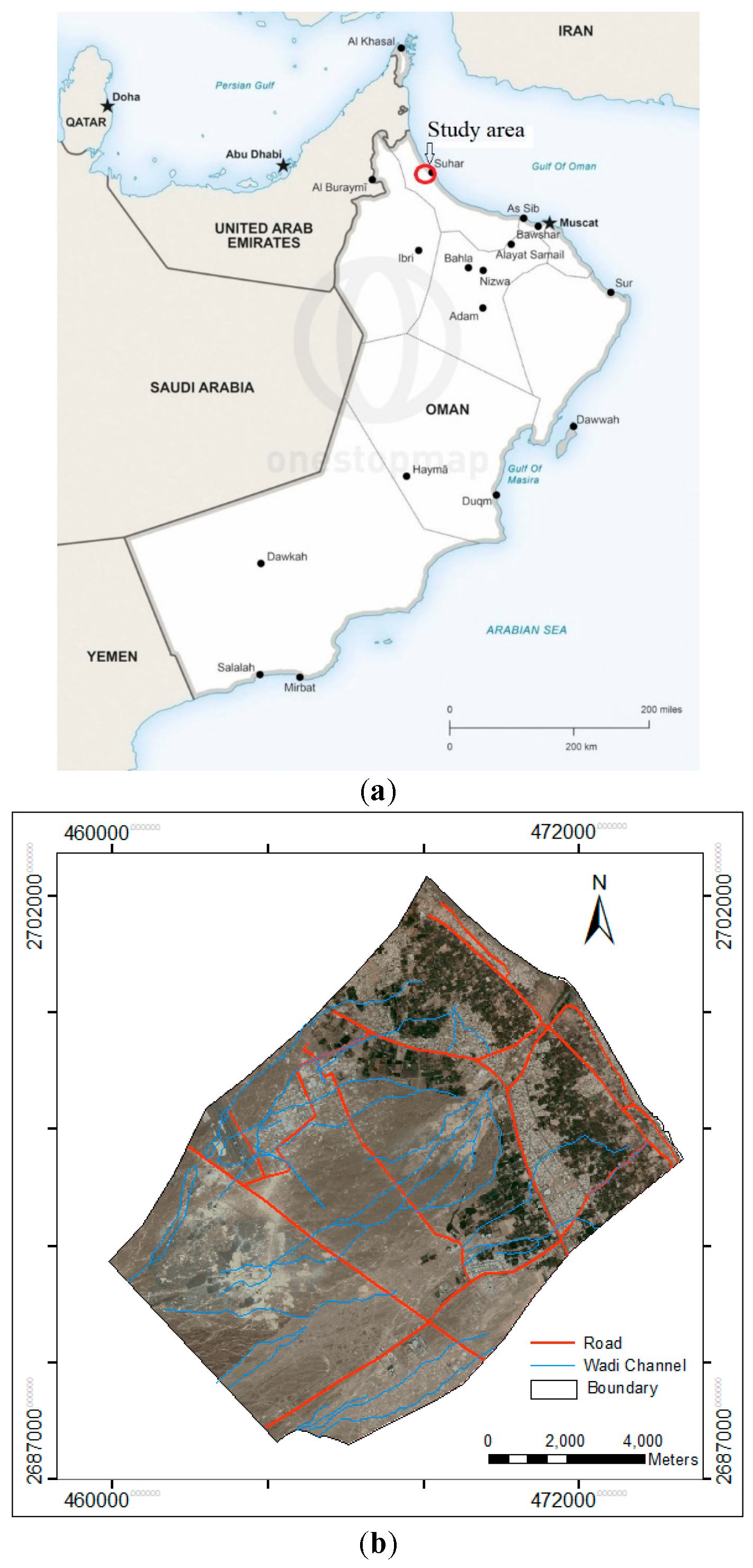

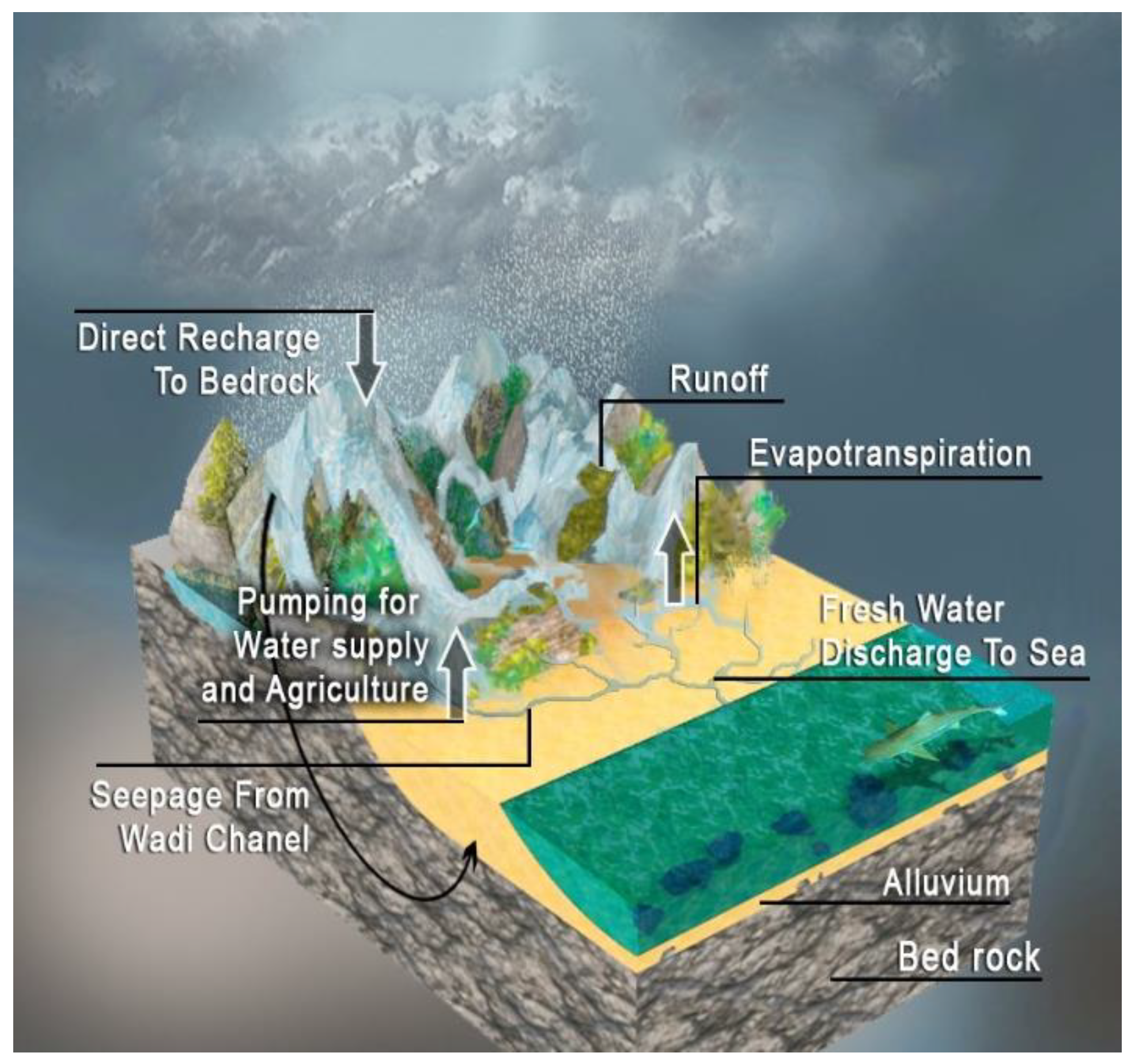
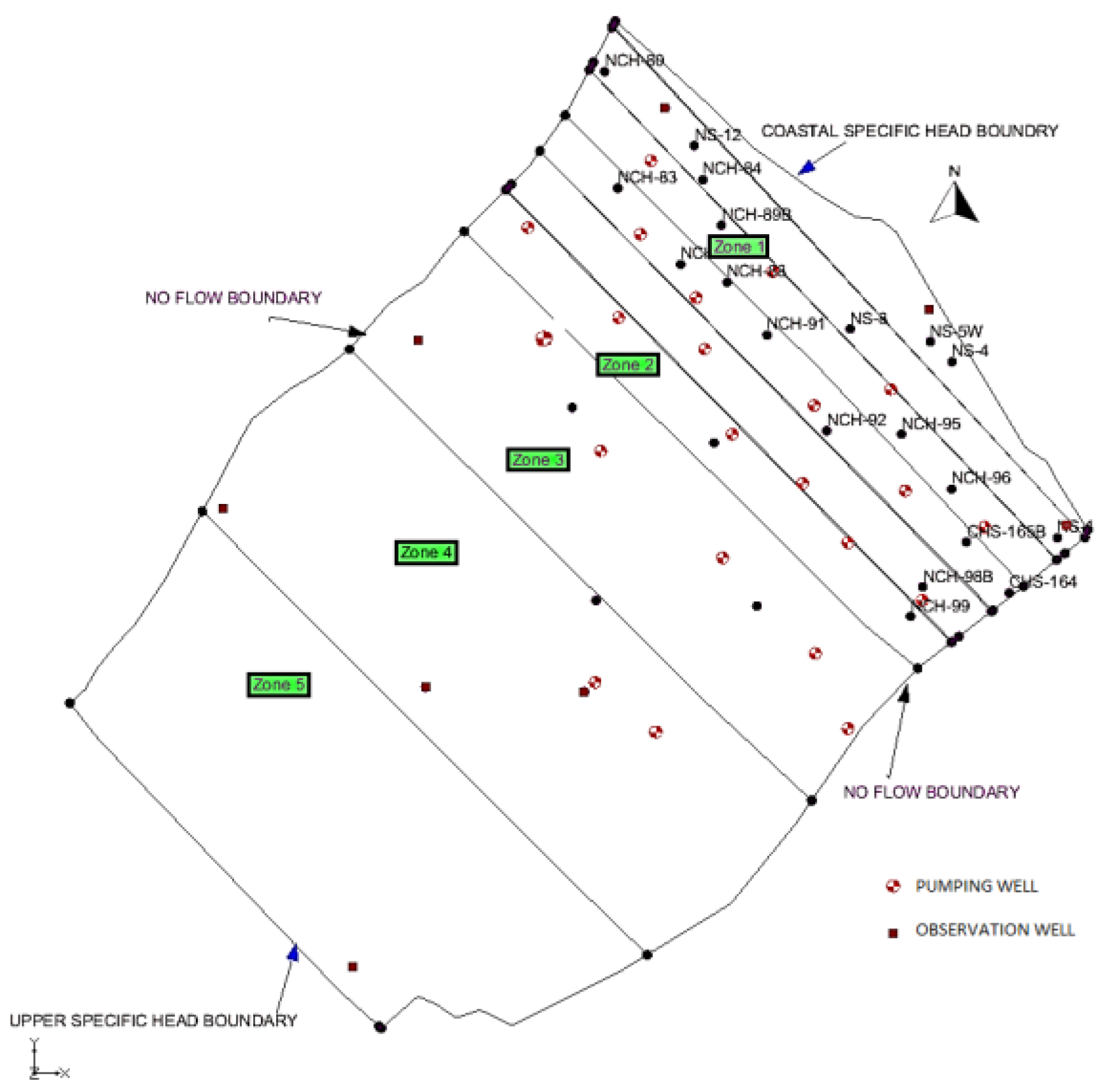
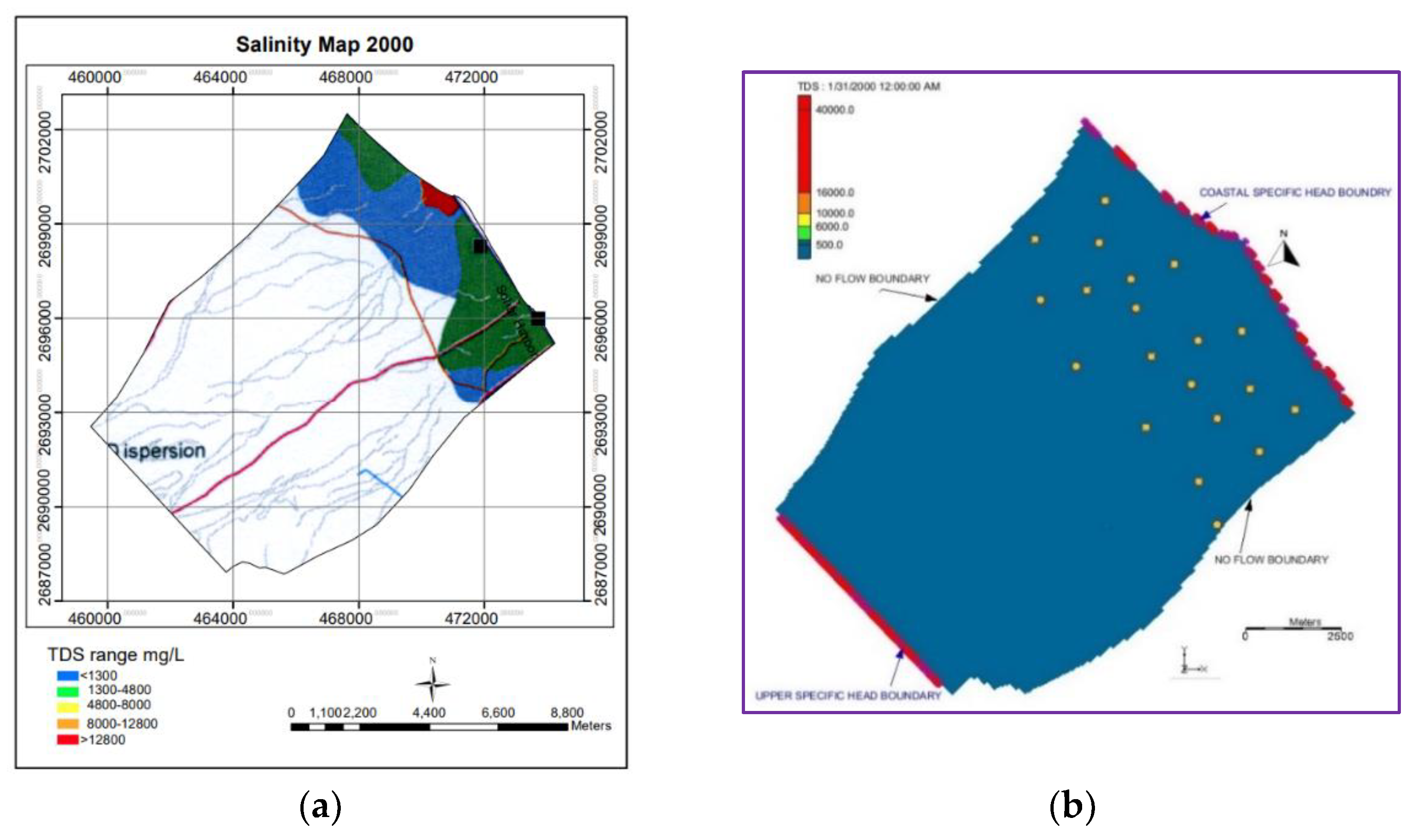


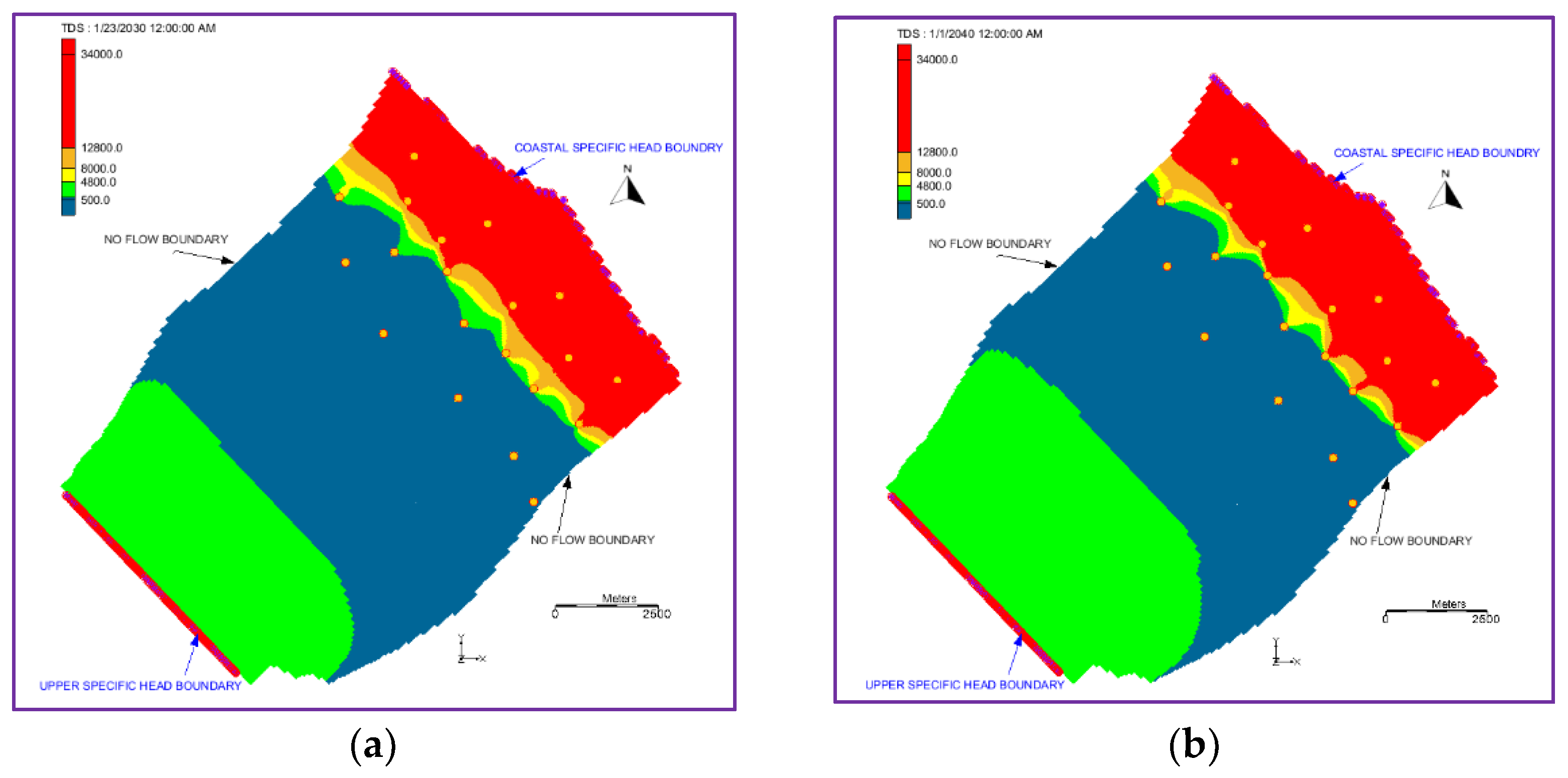
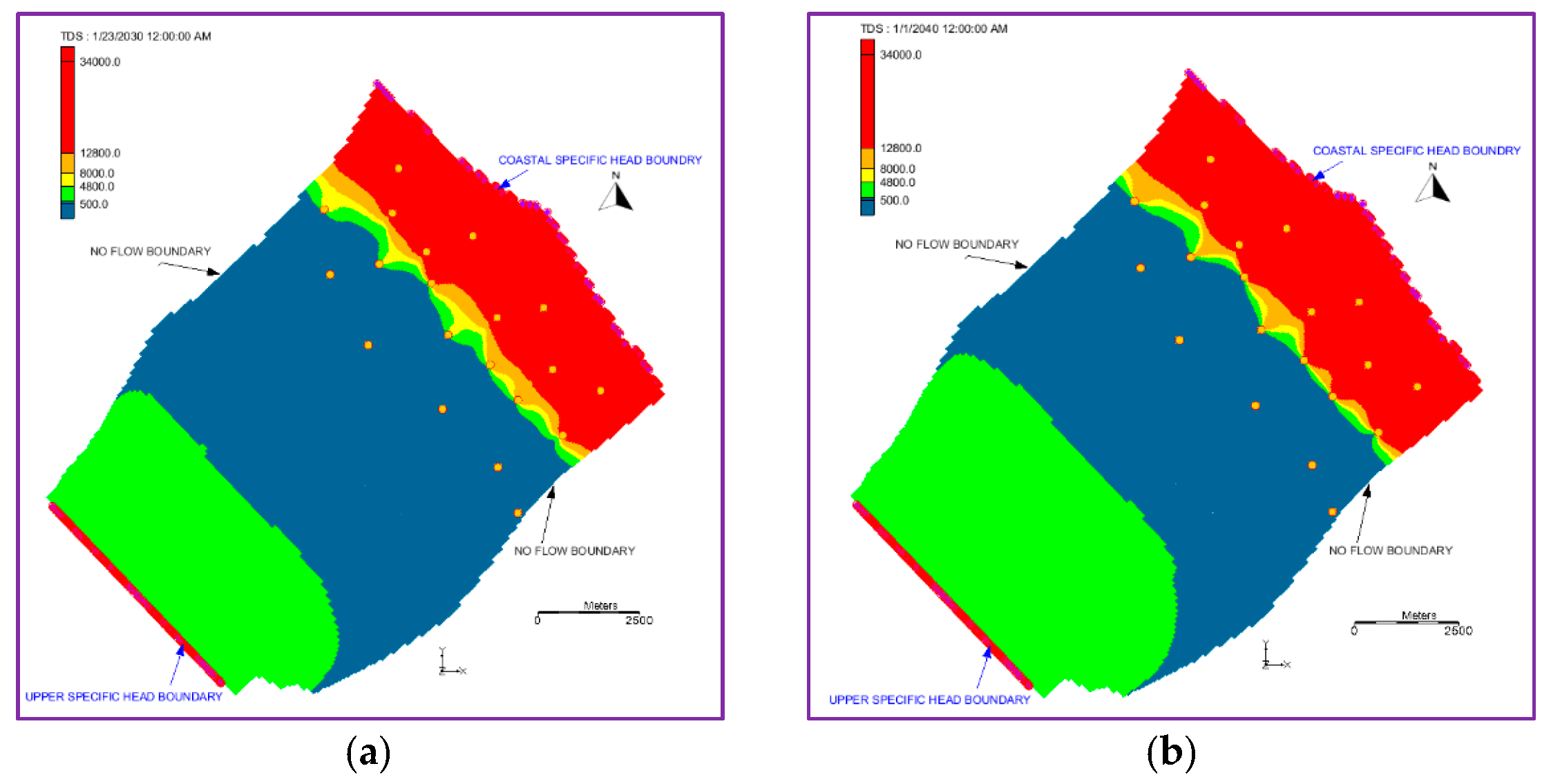
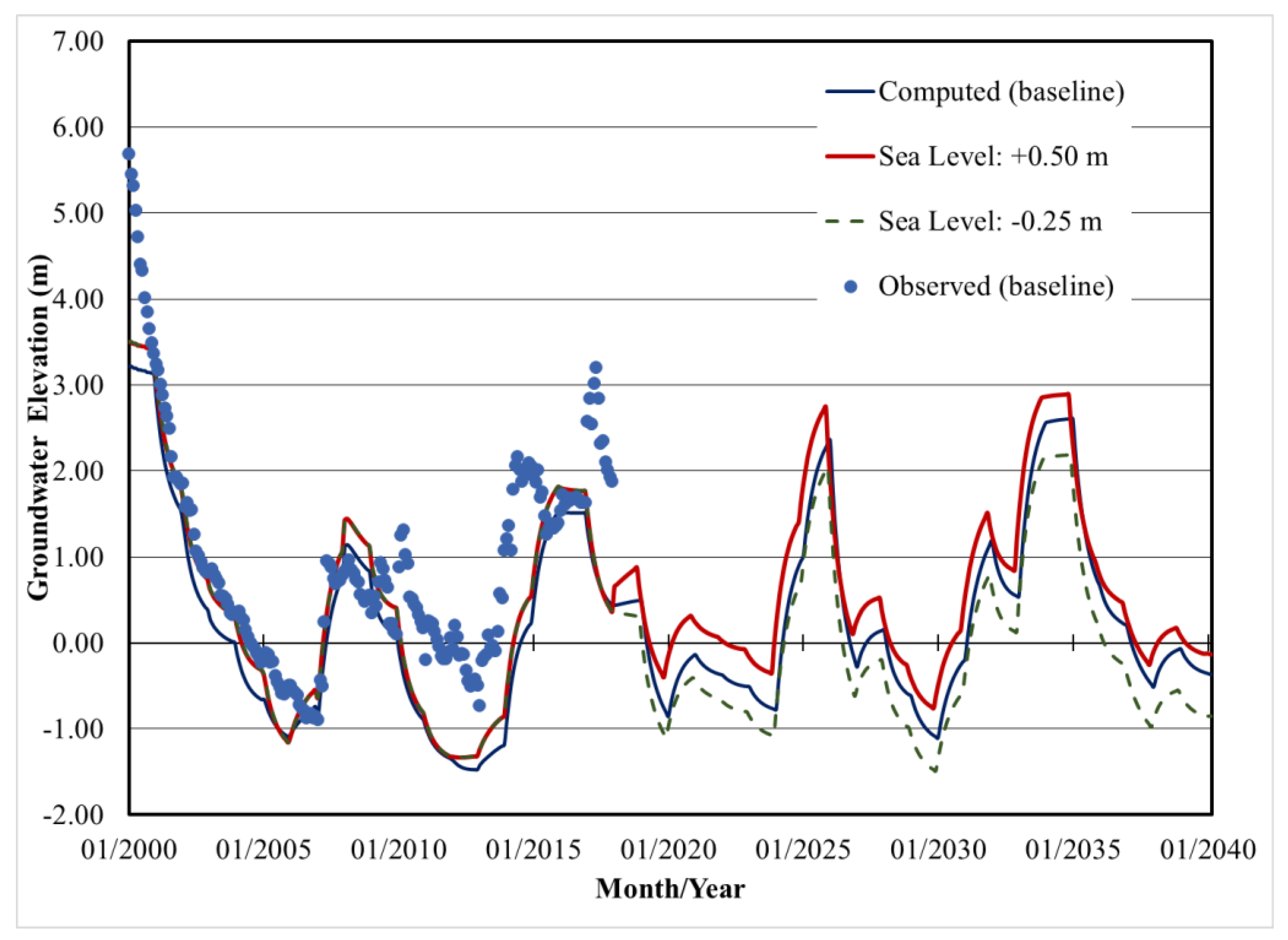
| Level of Salinity | Classification | Water Salinity | |
|---|---|---|---|
| TDS (mg/L) | EC (µs/m) | ||
| Class 1 | Freshwater | <1500 | 2.14 |
| Class 2 | Low Salinity | 1500–3000 | 2.14–4.30 |
| Class 3 | Moderate Salinity | 3000–5000 | 4.30–7.0 |
| Class 4 | Moderately High Salinity | 5000–7000 | 7.0–10.0 |
| Class 5 | High Salinity | 7000–10,000 | 10.0–15.0 |
| Class 6 | Very High Salinity | >10,000 | >15.0 |
| S. No | Region/Aquifer | Country | Observed SalinityValues TDS (ppm) | Reference/s |
|---|---|---|---|---|
| 1 | Dammam Aquifer | Bahrain | 2097–53,562 | [41] |
| 2 | Al-Raudhatain/Umm Al-Aish | Kuwait | 350–2400 | [42] |
| 3 | Kuwait Aquifer | Kuwait | 3000–8000 | [43] |
| 4 | Kuwait Aquifer | Kuwait | 1649–98,692 | [44] |
| 5 | Salalah Coastal Aquifer | Oman | 446–6305 | [30] |
| 6 | Al Batinah Coastal plain | Oman | 849–53,562 | [11,14,40] |
| 7 | Gulf of Aqaba | Saudi Arabia | 800–10,018 | [2] |
| 8 | Jazan Aquifer | Saudi Arabia | 217–8010 | [34] |
| 9 | Saq Aquifer | Saudi Arabia | 600–1180 | [3] |
| 10 | Al Lusab Basin | Saudi Arabia | 646–12,860 | [45] |
| 11 | Abu Dhabi Emirates Aquifer | United Arab Emirates | ≤1500–140,000 | [46] |
| 12 | Wadi Ham | United Arab Emirates | 15,000–30,374 | [12] |
| 13 | Al-Wakrah | Qatar | 2420–9210 | [47] |
| 14 | Wadi Siham, Tihama Basin | Yemen | 363–9610 | [48,49] |
| Observation Well | Observed Head (m) | Computed Head (m) | Difference |
|---|---|---|---|
| EA1 | 4.45 | 4.70 | −0.25 |
| JA5 | 7.75 | 6.50 | 1.25 |
| NJ1 | 0.52 | 0.85 | −0.33 |
| NJ2 | 0.42 | 1.00 | −0.58 |
| NJ10 | 1.40 | 1.20 | 0.20 |
| NJ9 | 3.05 | 3.38 | −0.33 |
| SARKM | 1.37 | 3.19 | −1.82 |
| DE5 | 4.73 | 4.20 | 0.53 |
| JA2 | 2.54 | 2.63 | −0.09 |
| Parameters | Calibrated Value | |
|---|---|---|
| Layer 1 | Layer 2 | |
| Hydraulic conductivity (m/day) | 7.5–163 | 4.0–180 |
| Vertical anisotropy | 20–25 | 10–25 |
| Porosity | 0.2–0.5 | 0.2–0.6 |
| Longitudinal dispersivity (m) | 14,000 to 15 | |
| Ratio of horizontal transverse dispersivity to longitudinal dispersivity | 0.1 | |
| Ratio of vertical transverse dispersivity to longitudinal dispersivity | 0.01 | |
| Scenario Type | Scenario | Description of the Scenario | Predicted Salinity Intrusion Inland (km) | |
|---|---|---|---|---|
| 2030 | 2040 | |||
| Pumping increment and reduction | 1 | Pumping at baseline pumping rates of 2017 | 2.39 | 2.56 |
| 2 | Pumping increment of 10% from the baseline pumping rate of 2017 | 2.42 | 2.57 | |
| 3 | Pumping increment of 20% from the baseline pumping rate of 2017 | 2.58 | 2.65 | |
| 4 | Pumping increment of 30% from the baseline pumping rate of 2017 | 2.69 | 2.73 | |
| 5 | Pumping reduction of 5% from the baseline pumping rate of 2017 | 2.19 | 2.41 | |
| 6 | Pumping reduction of 10% from the baseline pumping rate of 2017 | 2.12 | 2.15 | |
| Sea level rise due to climatic changes | 7 | Sea level rise as per IPCC prediction | 2.60 | 2.63 |
| 8 | Sea level rise @ + 0.25 m to the base sea level | 2.60 | 2.65 | |
| 9 | Sea level rise @ + 0.50 m to the base sea level | 2.61 | 2.70 | |
| 10 | Sea level rise @ − 0.25 m from the base sea level | 2.52 | 2.59 | |
Publisher’s Note: MDPI stays neutral with regard to jurisdictional claims in published maps and institutional affiliations. |
© 2022 by the authors. Licensee MDPI, Basel, Switzerland. This article is an open access article distributed under the terms and conditions of the Creative Commons Attribution (CC BY) license (https://creativecommons.org/licenses/by/4.0/).
Share and Cite
Akhtar, J.; Sana, A.; Tauseef, S.M.; Tanaka, H. Numerical Modeling of Seawater Intrusion in Wadi Al-Jizi Coastal Aquifer in the Sultanate of Oman. Hydrology 2022, 9, 211. https://doi.org/10.3390/hydrology9120211
Akhtar J, Sana A, Tauseef SM, Tanaka H. Numerical Modeling of Seawater Intrusion in Wadi Al-Jizi Coastal Aquifer in the Sultanate of Oman. Hydrology. 2022; 9(12):211. https://doi.org/10.3390/hydrology9120211
Chicago/Turabian StyleAkhtar, Javed, Ahmad Sana, Syed Mohammed Tauseef, and Hitoshi Tanaka. 2022. "Numerical Modeling of Seawater Intrusion in Wadi Al-Jizi Coastal Aquifer in the Sultanate of Oman" Hydrology 9, no. 12: 211. https://doi.org/10.3390/hydrology9120211







